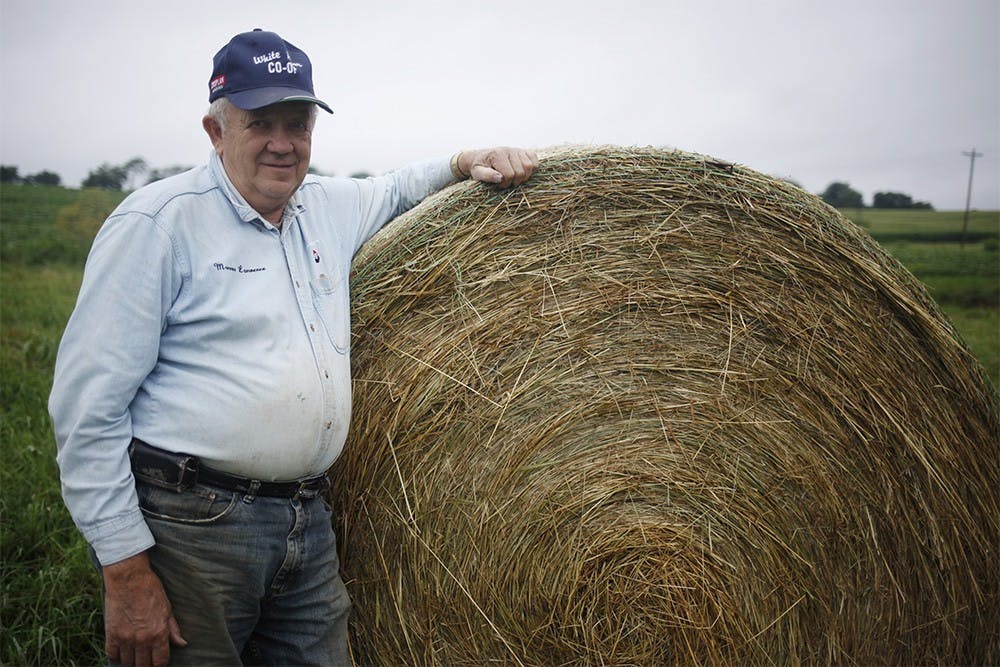There's an old saying about corn crops: "Knee high by the Fourth of July." Hay farmer Joe Peden said the saying stopped being accurate when farmers stopped using horses to harvest.
Peden harvests hay and rents out farmland in Monroe County. He said corn should be growing by June 4. But by mid-July, his renters’ corn is two weeks behind schedule and just beginning to grow tassels.
May 2018 to April 2019 was the wettest 12 month period on record in the United States, according to the U.S. Department of Agriculture. Heavy rain and snowfall saturated the ground with water, so 49% of U.S. corn planting was not completed by May 19, a record low.
Peden harvests hay on a 200 acre plot. He said he prefers to have three days with no rainfall before he cuts the hay so the hay is dry.
"I don't like to get my hay wet, so I won't cut it if it's a 20% chance," Peden said. "But that's been everyday."
Peden said he is still cutting his first round of hay. Normally, he would be on his second cutting.
"I don't even hardly remember last year after this year's disaster," Peden said.
Peden rents farmland to crop farmers. He said his renter Jeff Deck had 400 acres under water during this year's heavy rainfall and flooding. Another one of Peden's renters, Larry Stanger, had his crops damaged by recent tornadoes and flooding.
Some of the farmland is too wet for heavy farm equipment to travel on, Peden said. This delays planting, fertilizing and the spraying of pesticides.
"It's a rat race, and the rats are four steps ahead," Peden said.
Farmers have had problems with the rain since fall of 2018, said Troy Hobson, the county executive director for the Monroe USDA Farm Service Agency. Heavy rainfall made it difficult for farmers to harvest crops last year. Hobson said the ground is beginning to dry but has a long way to go.
Corn and soybean farmers normally plant their crops in mid-May, Hobson said. But many could not get seeds in the ground until mid- to late-June.
Hobson said the livelihood of farmers and their families could be affected within the next year. It is difficult to estimate profit loss until farmers finish harvesting and competitively price their product.
"If they can't make a profit, then it's gonna be tough to keep going," Hobson said. "They have obligations to make a living like everyone else."
Hobson said this year's crop yield may affect pig and cow farmers as well. Grain, often corn, is fed to pigs and cows. If there is less corn to feed the animals than in previous years, the price of corn may go up.
According to a press release, Gov. Eric Holcomb requested the USDA grant agricultural disaster designation for 88 Indiana counties, including Monroe. Holcomb’s press secretary Rachel Hoffmeyer said the request is still being considered.
Hobson said any disaster events can be cause for an agricultural disaster designation.
"It takes a 30% loss of just one crop," Hobson said. "It could be due to flooding, excessive rainfall or any kind of disaster event."
If Holcomb's request is granted, struggling farmers will be able to apply for low interest loans from the USDA.
Michael Hicks, owner of Living Roots Farm, said this year has not been more difficult for him than years past. The only change he has noticed in his crops is more weeds.
"This is one of our highest harvests ever," Hicks said.
Hicks farms differently than most large scale farms. He only grows on five acres of his 75 acre farm and plants roughly 300 varieties of crops.
"We have all the produce items you think of and some you don't," Hicks said. "All of our eggs aren't in one basket."
Hicks said his diversified farm uses raised beds for planting. These beds come six to eight inches off the ground and are five feet wide. He said the beds prevent drowning and help drainage.
Hicks said he and his employees plan to harvest 80,000 pounds of food by the end of the season. By using specialized smaller equipment and doing work by hand, Hicks said he is able to adapt to the weather conditions.
Hicks said struggling farmers should work on building their farmland's soil for better drainage.
"It's a hard model to fix when you only plant one crop," Hicks said.




